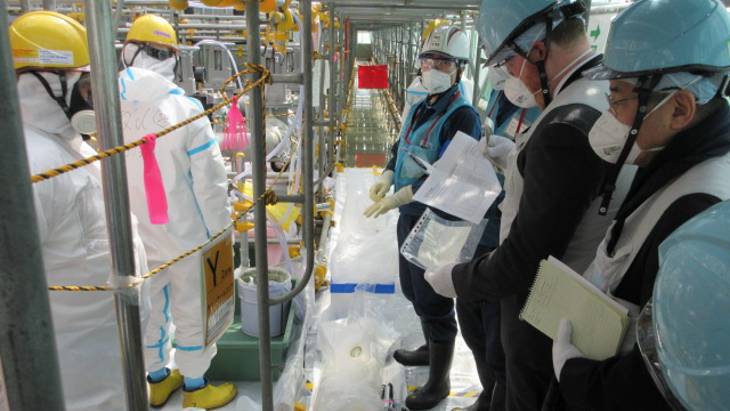IAEA progress report on regulatory plans for Fukushima water release

Japan announced in 2021 that it planned to release treated water stored at the damaged Fukushima Daiichi plant into the sea, and asked the IAEA to review its plans against IAEA safety standards which "reflect an international consensus and serve as a global reference for protecting people and the environment from the harmful effects of ionizing radiation".
The review of regulatory aspects is one component of the task force's three-pronged review, to be carried out before, during and after the discharge of water that has been through the Advanced Liquid Processing System (ALPS). The other two components are the review of technical aspects related to safety of the proposed discharge of ALPS-treated water - with the first report on this topic released in April this year - and conducting independent sampling and analysis.
The task force conducted a mission to Japan on 21-25 March to review the regulatory aspects of the planned water release. In this mission, the team reviewed the regulatory process implemented by Japan's Nuclear Regulation Authority (NRA) for the authorisation of the discharge of ALPS treated water, including the approach and criteria followed by the NRA in its review of Tokyo Electric Power Company's (Tepco's) radiological environmental impact assessment (REIA) and its implementation plan.
The mission team has now released a report setting out their initial observations. The report compiles the findings under five topics: the responsibilities and functions of the government; major principles and safety objectives; the authorisation process; source monitoring and environmental monitoring; and public consultation and involvement of interested parties.
The task force said the NRA "serves as the independent regulatory body within Japan, has promulgated and implemented an appropriate legal and regulatory framework for safety, and holds the responsibility for assessing the safety of the proposed discharge of ALPS treated water." It stressed the importance of fully documenting the process that the NRA is using to authorise the discharge of ALPS-treated water, along with the criteria that the NRA is using to approve the authorisation of the discharges and the conditions placed on Tepco in this authorisation.
The report notes the involvement of the NRA in Japan's current Comprehensive Radiation Monitoring Plan for environmental monitoring and specifically how this supports the requirement for independent monitoring by the regulatory body. The task force highlighted the importance of maintaining a strong connection between the characterisation of the source term and the design of source and environmental monitoring programmes, as well as linking the environmental monitoring programme to the results of the REIA. The task force noted the importance of establishing and communicating a clearly-defined plan for source monitoring.
The NRA is following an open and transparent approach for communicating with interested parties with regard to the discharge of ALPS-treated water, the report says. The task force also noted that the NRA recognises that "the main concern of interested parties and the Japanese public is the reputational damage caused by the discharge and, as a result, societal acceptance constitutes an important factor in the optimisation process".
"The Task Force has released this progress report to update the international community on our observations at this stage of the process," said Gustavo Caruso, director of the IAEA's Department of Nuclear Safety and Security and chair of the task force. "The IAEA's review, and the NRA's domestic regulatory review, are both ongoing processes and we continue to coordinate to ensure a complete understanding of what Japan is doing."
The task force will return to Japan for another mission covering regulatory aspects in early 2023. Preparing for the work ahead, the task force noted the importance of continuing to review the regulatory process and NRA's work as construction and inspections will take place.
In part used to cool melted nuclear fuel at Fukushima Daiichi, the water has been treated and purified using the ALPS system and then stored in around 1000 tanks at the site. ALPS removes most of the radioactive contamination, with the exception of tritium. The total tank storage capacity on site amounts to about 1.37 million cubic metres and all the tanks are expected to be full soon.
Japan's discharge of the water is expected to begin during the first half of 2023, but the entire operation could last for decades. In August last year, Tepco announced plans for the construction of an undersea tunnel, about one kilometre in length, for the discharge of the treated water.
Nearby countries have been alarmed by Japan's plan, but the IAEA says that the level of tritium in the water will be "well below national regulatory limits and the World Health Organisation standards for drinking water".
Prior to the discharge of the ALPS-treated water starting, the IAEA will issue a full report containing the combined conclusions of the task force across all aspects of the IAEA's review.









_88592.jpg)
_66488.jpg)

